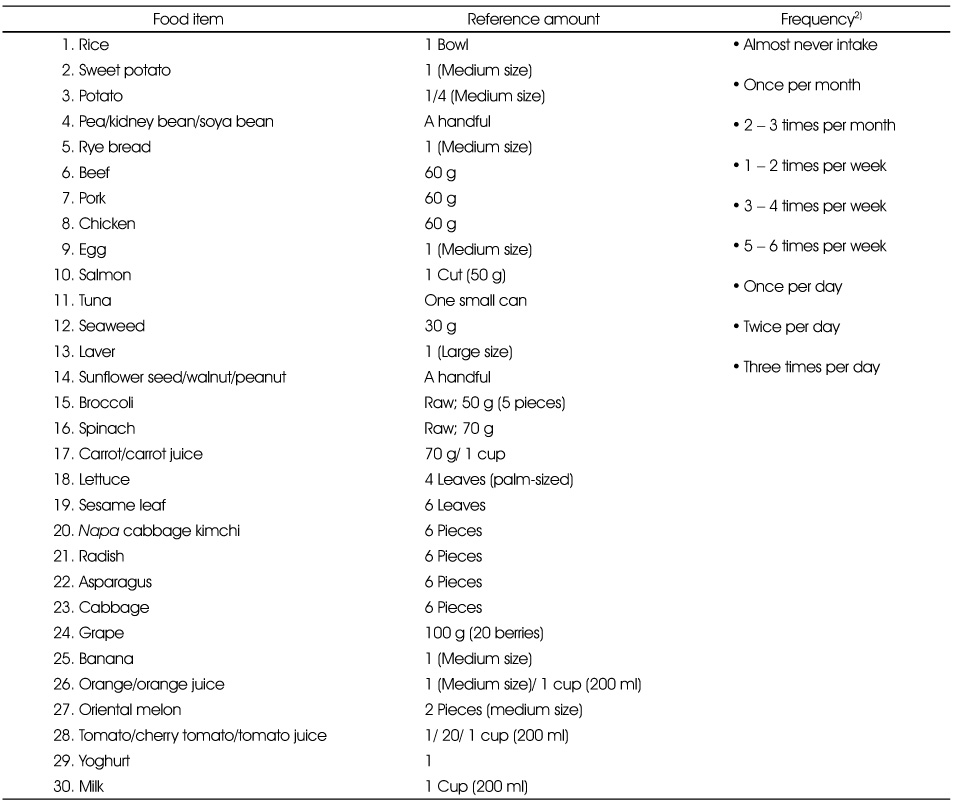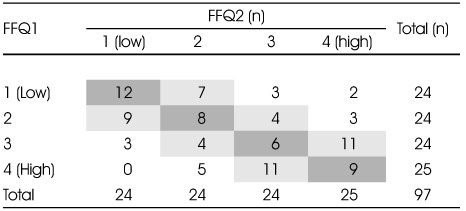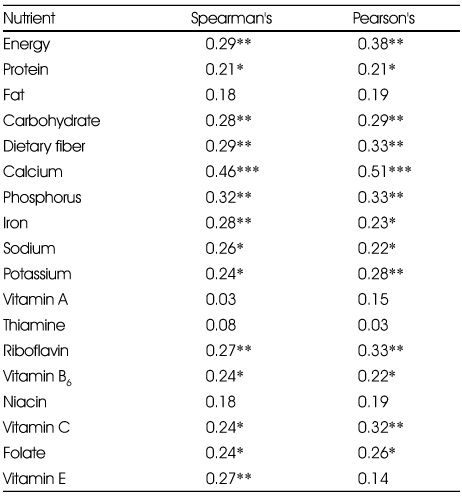References
1. Ahn KH, Yoo CJ, Kim YC. Product differentiation strategy of DONGWON F&B through brand management. Korean J Mark 2007. 9(3)167–185.
2. Ahn HS, Jeong EY, Kim SY. Studies on plasma homocysteine concentration and nutritional status of vitamin B6, B12 and folate in college women. Korean J Nutr 2002. 35(1)37–44.
3. Ahn YJ, Lee JE, Cho NH, Shin C, Park C, Oh BS, Kim KC. Validation and calibration of semi-quantitative food frequency questionnaire-with participants of the Korean health and genome study-. Korean J Community Nutr 2004. 9(2)173–182.
4. Bae HS, Cho YH, Kim JY, Ahn HS. Comparison of nutrient intake and antioxidant status in female college students by skin types. Korean J Community Nutr 2006. 11(1)63–71.
5. Bae HS, Choi SI, Ahn HS. Nutritional and antioxidant status by skin types among female adults. Nutr Res Pract 2010a. 4(3)215–221.
6. Bae HS, Kim SY, Ahn HS, Cho YK. Comparison of nutrient intake, life style variables, and pregnancy outcomes by the depression degree of pregnant women. Nutr Res Pract 2010b. 4(4)323–331.
7. Baer HJ, Blum RE, Rockett HR, Leppert J, Gardner JD, Suitor CW, Colditz GA. Use of a food frequency questionnaire in American Indian and Caucasian pregnant women: a validation study. BMC Public Health 2005. 5135–145.
8. Bang SW, Lee SS. The factors affecting pregnancy outcomes in the second trimester pregnant women. Nutr Res Pract 2009. 3(2)134–140.
9. Boucher B, Cotterchio M, Kreiger N, Nadalin V, Block T, Block G. Validity and reliability of the Block98 food-frequency questionnaire in a sample of Canadian women. Public Health Nutr 2006. 9(1)84–93.
10. Brown JE, Isaacs JS, Krinke UB, Murtaugh MA, Sharbaugh C, Stang J, Wooldridge NH. Nutrition through the life cycle 2008. third editionth ed. Belmont, CA: Thomson/Wadsworth; 53–54.
11. Canfield MA, Collins JS, Botto LD, Williams LJ, Mai CT, Kirby RS, Pearson K, Devine O, Mulinare J. National Birth Defects Preventin Network. Changes in the birth prevalence of selected birth defects after grain fortification with folic acid in the United States: findings from a multi-state population-based study. Birth Defects Res A Clin Mol Teratol 2005. 73(10)679–689.
12. Clover E, Miller M, Bannernan E, Magarey A. Relative validation of a short food frequency questionnaire to assess calcium intake in older adults. Aust N Z J Public Health 2007. 31(5)450–458.
13. Gibson RS. Principles of nutritional assessment 1990. New York: Oxford University Press; 11.
14. Goldbohm RA, van den Brandt PA, Brants HAM, van't Verr P, AL M, Stunnans F, Hermus RJJ. Validation of a dietary questionnaire used in a large-scale prospective cohort study on diet and cancer. Eur J Clin Nutr 1994. 48253–265.
15. Green NS. Folic acid supplementation and prevention of birth defects. J Nutr 2002. 1322356S–2360S.
16. Grosse SD, Collins JS. Folic acid supplementation and neural tube defect recurrence prevention. Birth Defects Res A Clin Mol Teratol 2007. 79(11)737–742.
17. Heu MS, Kim HJ, Yoon MS, Park KH, Shin JH, Lee TG, Kim JG, Kim JS. DHA enrichment of salmon patty using emulsion curd and its component characteristics. Korean J Fish Aquat Sci 2010. 43(4)285–292.
18. Hyun TS, Han YH. Comparison of folate intake and food sources in college students using the 6th vs 7thnutrient data base. Korean J Nutr 2001. 34(7)797–808.
19. Ji SK, Kim HS, Choi HM. A study on development and validation of food frequency questionnaire for estimating energy intake of women in child-bearing age. Korean J Nutr 2008. 13(1)111–124.
20. Jin HO, Lim HS. Major foods for folate and their folate contents of Korean child-bearing women. J Korean Soc Food Sci Nutr 2001. 30(1)152–158.
21. Jung SW, Lee NJ, Lee KG, Hong KW, Lee SJ. Changes in microbiological contamination in tuna (Katsuwonus pelamis) of various thawing temperature. Food Engineering Progress 2006. 10(3)186–191.
22. Khan NC, Mai LB, Hien VT, Lam NT, Hoa VQ, Phuong TM, Nhung BT, Nakamori M, Shimizu Y, Yamamoto S. Development and validation of food frequency questionnaire to assess calcium intake in postmenopausal Vietnamese women. J Nutr Sci Vitaminol 2008. 54124–129.
23. Kim EJ, Cha BK. Weight control behaviors in female college students. Korean J Women Health Nurs 2007. 13(4)320–326.
24. Kim HC, Kim MR. Analysis on awareness and practices for diet according to lifestyles of college students. Korean J Hum Ecol 2010. 19(1)157–165.
25. Kim MK, Lee SS, Ahn YO. Reproducibility and validity of a self-administered semiquantitative food frequency questionnaire among middle-aged men in Seoul. Korean J Community Nutr 1996. 1(3)376–394.
27. Korean Dietetic Association. Seeing pictures of food weight estimated by eye 1999. Seoul: KDA;
28. Korean Nutrition Society. Dietary reference intakes for Koreans 2010. The Korean Nutrition Society; 607.
29. Lee SY. Assessment of dietary intake and diet quality obtained by 24-hour recall method in Korean adults living in rural area 1997. Seoul National University; Dissertation.
30. Lim HS, Jin HO, Lee JA. Dietary intakes and status of folate in Korean women of child-bearing potential. Korean J Nutr 2000. 33(3)296–303.
31. Lim JY, Rha HB. Weight control and associated factors among health-related major female college students in Seoul. Korean J Community Nutr 2007. 12(3)247–258.
33. Mikkelsen TB, Osler M, Oslen SF. Validity of protein, retinol, folic acid and n-3 fatty acid intakes estimated from the food-frequency questionnaire used in the Danish National Birth Cohort. Public Health Nutr 2006. 9(6)771–778.
34. Mouratidou T, Ford F, Fraser RB. Validation of a food frequency-questionnaire for use in pregnancy. Public Health Nutr 2006a. 9515–522.
35. Mouratidou T, Ford F, Prountzou F, Fraser R. Dietary assessment of a population of pregnant women in Sheffield, UK. Br J Nutr 2006b. 96(5)929–935.
36. Noia JD, Contento IR. Use of a brief food frequency questionnaire for estimating daily number of servings of fruits and vegetables in a minority adolescent population. J Am Diet Assoc 2009. 1091785–1789.
37. Park JW, Park HM, Ha NS. A study on the obesity and weight control methods of college students. J Korean Acad Psychiatr Ment Health Nurs 2004. 13(1)5–13.
38. Park KY, Yoon MS, Kim JG, Kim HJ, Shin JH, Lee JS, No YI, Heu MS, Kim JS. Preparation and characterization of canned salmon frame. Korean J Fish Aquat Sci 2010. 43(2)93–99.
39. Son SM, Huh GY, Lee HS. Development and evaluation of validity of dish frequency questionnaire (DFQ) and short DFQ using Na index for estimation of habitual sodium intake. Korean J Community Nutr 2005. 10(5)677–692.
40. Swierk M, Williams PG, Wilcox J, Russell KG, Meyer Bj. Validation of an Australian electronic food frequency questionnaire to measure polyunsaturated fatty acid intake. Nutrition 2011. 27(6)641–646.
41. Vriese SR, Henauw S, Dhont M, Christophe AB. Estimation of dietary fat intake of Belgian pregnant women. Ann Nutr Metab 2001. 45273–278.
42. Wardle J, Haase AM. Steptoe a body image and weight control in young adults: international comparisons in university students from 22 countries. Int J Obes (Lond) 2006. 30644–651.
43. Willett W. Nutritional epidemiology 1998. 2nd Edth ed. NewYork: Oxford University Press;
44. Xia W, Sun C, Zhang L, Zhang X, Wang J, Wang H, Wu L. Reproducibility and relative validity of a food frequency questionnaire developed for female adolescents in Suihua, North China. PLoS ONE 2011. 6(5)e19656.
45. Xu L, Dibley MJ, D'Este C. Reliability and validity of a food-frequency questionnaire for Chinese postmenopausal women. Public Health Nutr 2004. 7(1)91–98.
46. Yim KS, Lee TY, Park HS. The development and validation of a food frequency questionnaire to assess diets of Korean adolescents. Korean J Community Nutr 2003. 8(2)149–159.
47. Yon MY, Hyun TS. Additional data for the folate database for foods common in Korea. Korean J Nutr 2005. 38(7)586–604.









